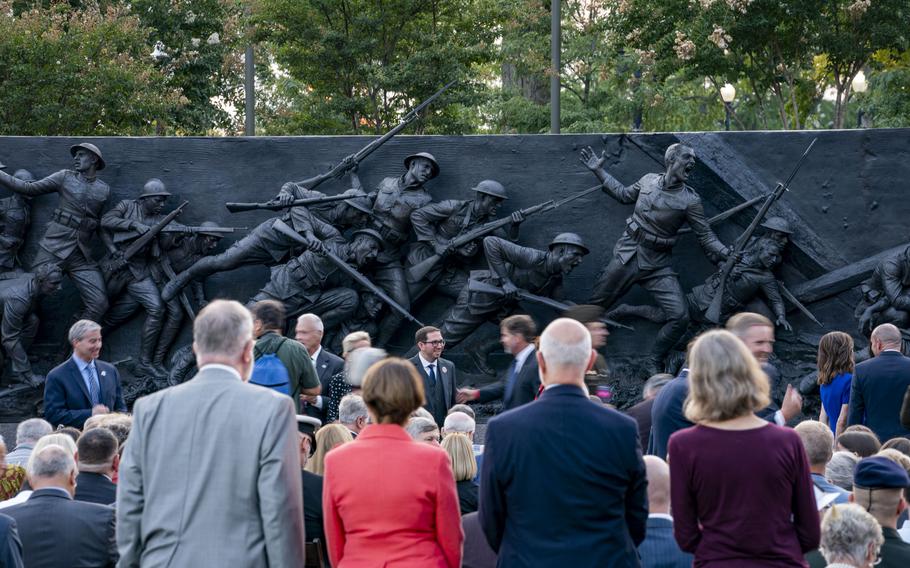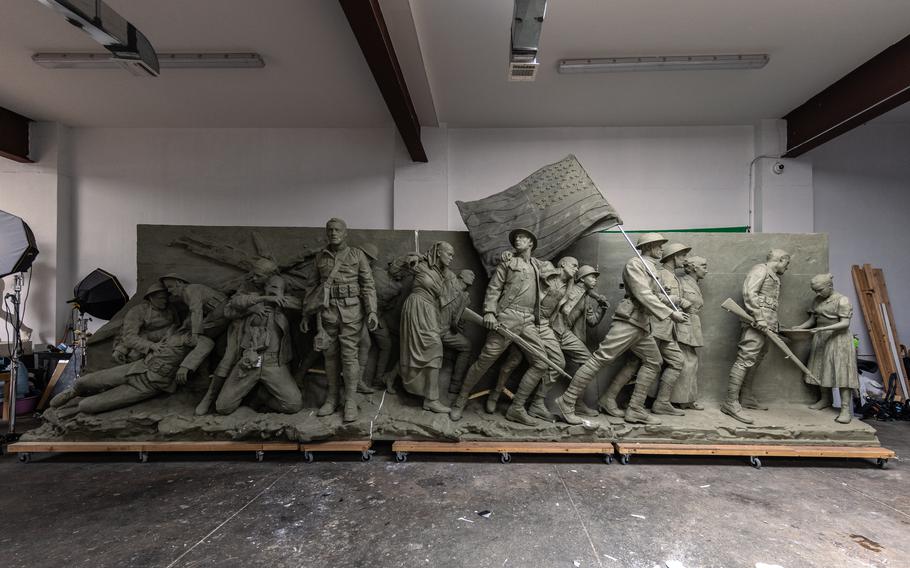
The centerpiece of the National World War I Memorial in Washington, “A Soldier’s Journey,” is unveiled on Friday. (Allison Robbert/The Washington Post)
The 58-foot-long bronze sculpture follows the story of an unnamed World War I soldier, beginning on the day he takes his helmet from his daughter’s hands and ships out. It shows anguished scenes of war, with soldiers fighting alongside nurses who tend their injuries. And finally, a homecoming.
Years in the making, the 25-ton sculpture called “A Soldier’s Journey” is the centerpiece of the National World War I Memorial and was unveiled Friday evening in a park at 14th Street and Pennsylvania Avenue NW, just blocks from the White House.
As the sun set on a breezy Washington evening, a crowd of veterans, military enthusiasts and others gathered to see the memorial. Observers lined barricades on Pennsylvania Avenue to watch the program. Some wore re-creations of World War I uniforms. The U.S. Army Band “Pershing’s Own” played the national anthem.
“This mammoth, epic, 60-foot-long bronze is about humans,” artist Sabin Howard said. “It is a memorial about us, we the people. It is a project that represents the everyman, the ones who make this country possible. And as I stand here in front of you, I am an example of why this country carries so much potential. It is the freedom to choose what we will do with the God-given gift of life. It is a country that grants us free will.”
The massive sculpture took about a decade to complete from inception to reveal. Forged in Stroud, England, it is now the largest free-standing high-relief bronze in the Western Hemisphere, according to the World War I Centennial Commission.
The finishing touches were applied on a sweltering August morning, as Howard and his crew filled in the gaps between five-ton pieces of bronze that had been cast at a foundry 3,500 miles away. Blowtorches in hand, they applied chemicals and heat to jump-start the oxidation process that will continue as long as the statue stands exposed to the elements, forming the patina that Howard said gives the memorial “a life of its own.” Howard created the piece alongside architect Joe Weishaar.

Artist Sabin Howard works on the new World War I memorial in Washington in August. (Allison Robbert/The Washington Post)
“The sculpture really shows the richness of our humanity,” Howard said. “It’s a very human piece.”
The work is the culmination of more than a decade of effort to bring a national World War I memorial to D.C. Funding this effort required the creative efforts of the commission, which tracked down family ties to the war to convince donors to fund the mission.
When the project began, the World War I Centennial Commission was an all-volunteer body, said Meredith Carr, deputy director of the commission. The group had no office space, no operating budget and no payroll. They needed a way to convince wealthy donors to bankroll a multimillion-dollar project to honor millions of U.S. veterans who were no longer alive.
Carr said the commission’s eureka moment came when they began digging through archives of war-era documents, where they found draft cards signed by relatives of several prominent and wealthy American families. They discovered cards signed by the fathers and grandfathers of former presidents, business moguls and celebrities.
When they showed surviving family members those old papers conscripting their ancestors into the war, the commission struck gold.
Suddenly, dozens of influential people wanted to be involved with the commission and the construction of the memorial, Carr said. Former presidents Jimmy Carter, Bill Clinton, George W. Bush and Barack Obama signed on to be honorary co-chairs. Donations came in from the Walton family, who own Walmart; Lilly Endowment Inc.; the NFL; General Motors; the Coca-Cola Foundation; and dozens of other companies, foundations and families with ties to the war.

Sculptors work on finishing touches to a scene in the World War I memorial in Washington, D.C. (Allison Robbert/The Washington Post)
Carol Moseley Braun, the former U.S. ambassador to New Zealand, said she found herself digging into her family’s connection to the war after the commission approached her to become a special adviser and help fundraise for the $44 million project.
Her grandfather, Thomas Davie, fought in a Black division of the then-segregated U.S. Army. The commission shared her grandfather’s draft papers, signed in his own handwriting and preserved for a century. In the bottom of an old box of photographs, she found an image of a young Davie in uniform that she said was painted in France while he was deployed.
She took a trip to the Western Front in France and visited the trenches her grandfather would have stood in nearly 10 decades ago. In one corner of an underground room, she saw an altar for prayers and her grandfather’s all-Black division carved into the limestone. Across the room, a stairwell was marked by the word “Hell” and an arrow pointing toward the long-abandoned war zone.
“It was emotionally overwhelming,” Moseley Braun said.
A family connection to a war that shaped the modern era spurred many others to collectively funnel millions of dollars into the effort to construct “A Soldier’s Journey.”
Retired Col. Jennifer N. Pritzker, a billionaire who runs the Tawani Foundation and founded the Pritzker Military Museum & Library in Chicago, was one of the first potential funders that the commission approached, Carr said. Pritzker gave a $5 million donation that allowed the commission to set up offices and begin fundraising more seriously.
Pritzker, who served in the Army and has a personal connection to the Great War through grandfathers on both sides of her family, said it was important to remember the conflict even 100 years later because of its ongoing influence on the modern era.
“I think World War I pretty much defined the world as we see it today,” Pritzker said.
She said our maps, borders, civil rights, weapons, technology and even fashion, like the wristwatch and trench coats, owe some credit to World War I. But few people alive today have a direct connection to the conflict. Memorials like the one installed in D.C. can connect people to that past.
“Even if all you do is look at the statues, or read a couple of Wikipedia articles [about the war],” Pritzker said, “these statues and the commission has done something.”

Part of “A Soldier’s Journey” is displayed at Sabin Howard’s studio in Englewood, N.J. The final sculpture is frozen in bronze. (Jeenah Moon/The Washington Post)